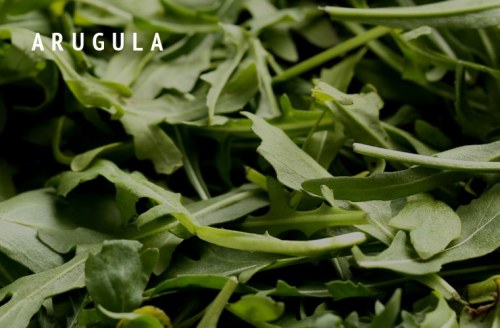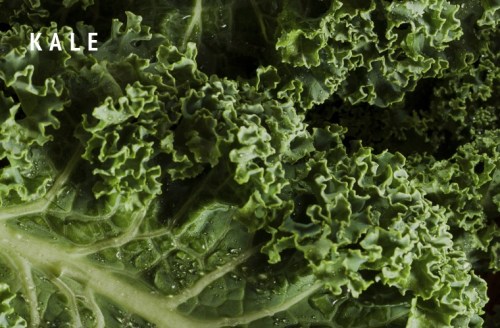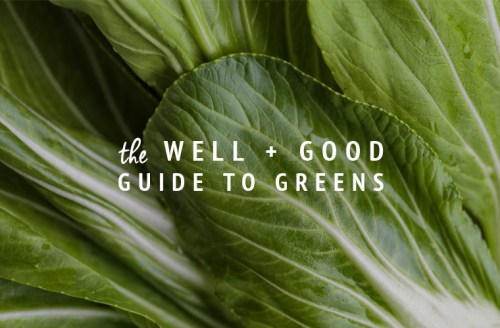Our editors independently select these products. Making a purchase through our links may earn Well+Good a commission
You put spinach in your smoothies, are well-versed in the benefits of dandelion greens, and could massage kale in your sleep. Raw or cooked, in a salad or a stir fry—doesn’t matter—you pile your plate with the nutrient-rich veggies.
And for good reason. “Greens are the powerhouses that contain very high concentrations of many of the vitamins, minerals, and nutrients we need to keep us healthy,” says cookbook writer Dana Jacobi, whose new cookbook The Power Greens Cookbook is dedicated to the dynamite leaves.
But are you maximizing your nutrient takeaway? The key, it turns out, is variety. All those leaves are full of different vitamins and minerals—and you want them all. Same goes for how you prepare your greens. “Raw is not necessarily better,” Jacobi explains. “Your body can actually absorb iron in spinach and chard better when they’re cooked, because it breaks down the cell walls.” Just make sure to add them into your warm and cozy meals at the very end: According to Sarah Britton, the holistic nutritionist behind My New Roots, it’s the best way to preserve the nutrients and make sure you’re not killing them before they even get in your belly.
Even though greens are good is practically hardwired into our brains, with whole aisles filled with the nutritious leaves, it can be hard to keep them all straight. That shouldn’t stop you from filling your cart with dark, leafy greens, however. “Two ways to know if a food is rich in nutrients is how they look and how they taste,” Jacobi explains. “Darker colors and stronger tastes mean more nutrients!”
But what is the difference between chard and collards, anyway? Which greens pack a mean protein punch and which are better than a multivitamin?
Keep reading for our rundown of some of the most powerful greens—from their nutrient profiles to the tastiest ways to prepare each one.

1. Arugula
The green known for its peppery bite has the most calcium of all the salad greens. Arugula is also packed with antioxidants (think vitamins A, C, and K) and manganese. “That combination is great for protecting your bones,” Jacboi says. And it can do way more than just act as an accent to your tossed salad. “It’s fun to use as an alternative to baby spinach—you can just wilt it,” she notes. Her kitchen advice? Try stirring arugula into risottos and soups, or adding them to a frittata.
2. Bok choy
This cruciferous green is not only delicious when stir-fried with garlic, it’s also a key supporter of a healthy gut. The green is full of magnesium and antioxidants, and helps the gut produce inflammation- and allergy-fighting substances. Bok choy leaves can be tougher, which makes them perfect for juicing. Jacobi’s favorite combination? Bok choy, apple, and ginger for a three-ingredient Asian-style super juice. For something a little easier to eat, reach for Shanghai bok choy (more commonly known as baby bok choy)—perfect for stir fries or adding a crunchy kick to salads.
3. Chard
This leaf is pretty on the inside and the outside. Antioxidants, iron, and chlorophyll are just some of the nutrients found in chard, whose stems are also packed with fiber. The green also contains carotenoids, which help to protect your eyes against harmful UV rays, and folate—key for healthy pregnancies. This is one green that Jacobi definitely recommends eating cooked, rather than raw. “Cooking chard helps diffuse the dry tannic quality,” she explains, adding that blanching chard will also get rid of its muddy quality (meaning it will be even more Instagram-worthy on your plate). Pair it with lentils or browned onions, or chop it up finely for a frittata.

4. Collard greens
If you’re a plant-based eater who has heard the question “How do you get enough protein?” time and time again, this leaf’s got your back. Collard greens pack 5 grams of protein per cup. They’re also loaded with calcium, cancer-preventing B6 vitamins, and the natural sleep aid tryptophan. Oh, and they make a great midnight snack: As Jacobi tells us, “You can make collard chips just like kale chips!” Crumble them on top of soups or eat them as a snack—you may be pleasantly surprised to notice they’re even a bit less bitter than their kale equivalent.
5. Dandelion greens
Eat your greens—ahem, flowers. Dandelion greens come from the same family as sunflowers and daisies, but they’re just as nutritious as the other similarly hued options in the supermarket. In fact, they’re all-stars when it comes to detoxification, since the greens are great for liver health and full of potassium to keep the body free of impurities. They may be a bit more bitter than what you’re used to—Jacobi calls them a “green lover’s green”—but there are ways to slowly add them in to your lunch routine. She recommends mixing them in with your go-to salad green for starters, or chopping them up and eating them blanched with olive oil and lemon juice for a Mediterranean-style salad.

6. Kale
This dark, nutrient-dense, leafy green more than lives up to the hype: It’s loaded with vitamins, minerals, fiber, protein…the list goes on. Kale also contains a category of phytochemicals called glucosinolates—a group of compounds that help to detoxify the liver and support other body functions. Another of the super-green’s super powers? “Kale protects us against the chemicals that promote the storage of body fat,” dishes Jacboi. Oh, and did we mention just how versatile it is? Massage it with lemon juice and olive oil for salad bases, blend it into your smoothie, roast it at low temperatures and turn it into kale chips—the possibilities are limitless. And if you’re not sure where to start, Jacobi’s favorite way to eat kale is braised. “Braising brings out the flavor and gives them a texture with body but not too much. You have control over the texture, without losing the flavor,” she explains. “Plus, the oil helps your body absorb the nutrients.”
7. Microgreens
Don’t let their miniature size fool you—microgreens’ nutritional value is supersized. But what, exactly, are they? Microgreens are veggie shoots (everything from arugula to radishes) picked as soon as the first leaves sprout. The tiny salad greens are full with vitamins that are often far more concentrated than their mature counterparts. And since microgreens include a range of types, you’re bound to be chomping on more nutrients than one variety can hold. “Adding a sprinkling of microgreens to a salad or sandwich is a great way to add a flavor kick and a nutrient boost,” Jacobi suggests. But be sure to buy these organic or at your local farmers’ market—the tiny leaves are fragile and can harbor bacteria, so you’ll want to show them a little extra love.
8. Romaine
If you normally throw iceberg lettuce into your salad bowl, it might be time to swap it out for some romaine. “The darker the leaves are, the better,” Jacobi says, explaining that the depth of the color corresponds with the nutritional value. This salad green is full of antioxidants and is also a great source of the natural sleep-enhancing amino acid tryptophan. And if you’ve only ever eaten romaine raw, Jacobi recommends branching out. “Lettuce is delicious slightly cooked—it has a great nutty flavor,” she notes, suggesting lightly stir frying it with white wine. That’s right: romaine and wine, together.
9. Spinach
You can find spinach just about everywhere—yes, even your local corner store. “I like to call it the convenience green,” says Jacobi. Good thing: It’s full of vitamins and minerals that are released differently, depending on how the green is prepared. While the carotenes and iron are more accessible when we eat spinach cooked, some nutrients are lost because of heat sensitivity. Luckily, spinach is incredibly versatile—you’re bound to enjoy it some way or another. When in doubt, just throw a fistful of spinach into your a.m. smoothie and hit “blend.”
Ready to go green? Get them fresh at the farmers’ market—here’s how to shop like a pro. And then incorporate your favorites into your weekly meal prep for lunches that will make your co-workers extremely jealous.
Originally published April 21, 2016; updated August 31, 2018.
Sign Up for Our Daily Newsletter
Get all the latest in wellness, trends, food, fitness, beauty, and more delivered right to your inbox.
Got it, you've been added to our email list.

















